Marketing Plan That Converts: SEO, Content & More

Here is one more fact that will send your marketing manager running to his office: 87 percent of corporations will tell you that they have a marketing strategy. Still, only 23 percent can tell you what it is without frantically searching their hard drive to find last quarter's PowerPoint presentation. So, when you shake your head in a yes, yes, I know you have just diagnosed your company with marketing amnesia.
Well, you are now in the crazy land of marketing plans- good intentions collide with the Excel spreadsheets, and "we will make it up as we go" is a strategy. Winging is not a marketing strategy; it is a formula to have your competitors serve you lunch as you are still trying to decide what to order.
What Exactly Is a Marketing Plan (And Why You Can't Live Without One)
So what we shall do will be to start by the lowest terms, since we must. Any marketing plan is your tactical scheme that shows how you will promote your services or goods, deliver to your target clientele, and attain your corporate objectives. Consider it your marketing GPS; without it, you are just wasting money, as there is no path.
But this is where others go wrong because they believe a marketing plan is fancy paperwork that one does and forgets. Wrong. It is a breathing blueprint that will change as your business and market conditions change, and that certain day, your CEO catches the innovation bug and decides to spin the whole company strategy after watching a TED talk on that subject.
The best thing about writing a marketing plan is its ability to turn your haphazard marketing activities into a well-organized, results-generating machine. It is hurling spaghetti against the wall or banging out an eight-course feast at a five-star restaurant.
The Key Elements of Marketing Strategy That Matter
Any marketing strategy must include some items which are not negotiable. Forget anyone, and you will be playing the marketing lottery with funds. What are the main aspects of marketing strategy that distinguish the specialists from the novices?

Mission Statement and Value Proposition: This is nothing like corporate filler; this is your North Star. You must ensure that your mission statement marketing is understandable to a five-year-old who could know what you do and why it is important. You are already defeated when your mission statement comes with a decoder pattern.
Identification of Target Market using Buyers Personas: The magic gets introduced. Developing in-depth buyer personas is not a wishful thing but a necessity. The fictional visualizations of your ideal customers must be as detailed as possible so that you can identify them in a lineup. What keeps them awake at night? What is it they laugh at? What is the greatest pain point? Pose these questions, and you will halfway have marketing gold.
All-inclusive Marketing Campaigns and Strategies: This is where your content marketing strategy, SEO marketing strategy, and even your social strategy meet like the Avengers of digital marketing. All the channels must complement each other and not be involved in a sibling rivalry of scrounging over the remaining pizza.
Marketing KPIs that Matter: So are KPIs the vanity measures you point to show yourself how much you are doing right? They must be information nuggets that you can act on to determine whether your marketing strategy is performing as expected or whether you need to panic. It is great to have website traffic, but the conversion rates do the money.
Budget Allocation: Money speaks, but it also walks. Forget about it as it walks around the corner or out of the door should you not be a smart spender. Your priorities should be put in your budget and not your wishful thinking.
Competitor Analysis: Know thine enemy, so they say. Knowing what your rivals are up to (and, worse still, what they are not up to) puts you in a strategic place.
Types of Marketing Plans: Because One Size Doesn't Fit All

You would never attend a board meeting and a beach party in the same ensemble, nor should you apply the same marketing plan in various cases. These are your marketing strategy wardrobe:
Product Launch Marketing Plans: Your red carpets. The little things count since there is only one first impression. These plans are demanding, time-based, and need to be coordinated in a way that would make military operations seem to be casual.
Blog Marketing Plan: Also known as a content marketing strategy on steroids, a blog marketing plan is a way to go if you are a content creator or business placing your bets on thought leadership. It has a source of editorial calendars, SEO optimization, promotion strategies, and a supply of coffee to keep a small nation going.
Plans with social media strategy: This random posting of memes is not social media marketing. The plans are aimed at platform-specific content and approach to engagement and monetizing followers into customers rather than mere online trophy-gathering.
SEO Marketing Plans: Digital marketing as a long-term strategy. These packages are for businesses that perceive that being listed on Google is not by chance but by having the right approach, time, and content that the Google algorithm will at least desire to present.
Time-Based Marketing Plans: Whether quarterly sprints or annual marathons, these plans break out your work within a certain period. Made to suit the needs of businesses that enjoy their marketing with a pinch of calendar panic.
How to Write a Marketing Plan That Doesn't Suck
How do you write a marketing plan that works according to the step-by-step procedure? Tighten your seat belt now; we will straighten up your marketing mess by turning it into a marketing strategy.

Formulate Your Mission Statement
Your mission statement as a base of marketing must answer three questions: What do you do? Whom do you do it to? What is the point of that? If you can not answer these in one breath, then it is time you hit the drawing board. This does not apply to sounding smart; it is all about clarity.
Claim Your KPIs in Marketing.
Select the metrics relevant to your bottom line. Traffic on the site is vanity; conversion is sanity. The open rate in email is curious; the click-through rate of email is a revenue builder. Choose the KPIs that relate directly to monetization, and you will never have to justify that the marketing budget is important.
Create More Detailed Buyer Persona
Developing generic superficial personas is where most marketing plans die--context-less personas that apply to everyone and, thus, apply to no one. Your buyer personas must be so specific that you can write their dating profile. Which social media do they utilize? At what time will they get an email? What can make them purchase? Become creepy-specific (in an entirely lawful and not-stalker sort of approach).
Plan Your Content Marketing
Your content is more than posts to your blog and Facebook updates: It is your brand talking to your customers. Create educational, entertaining, and conversion plans. Design a calendar of edits that your future self will be thankful for, and build a content marketing strategy that will satisfy your audience's needs and serve its business interests.
Do a Competitor Analysis.
Study your competitors as they are marketing the Olympics. Which areas are they excelling in? Where is the ball being dropped? What are the opportunities not taking advantage of that you can take advantage of? Read their newsletters, follow them on social media, use their tools, and become their number one fan and rival simultaneously.
Strategically Spend your Budget
Money must follow strategy, not vice versa. Put your money where your audience is and not where you would have liked them to be. Regarding social media platforms, do not spend most of your budget on LinkedIn advertising when your buyer personas are scrolling TikTok because it seems to be more professional.
Identify Clear Roles and Responsibilities
Assigning clear roles and responsibilities is one thing that kills a marketing plan very quickly. Who is the content maker? Who owns social media? Who is studying data? Who picks up the coffee when everybody is late to meet deadlines? Assign responsibility so that nobody can say they thought you were doing that.
Prepare to Monitor and Optimize
Your marketing plan is not a display in a museum but an ongoing document; as such, it should be continuously adjusted in light of actual performance. Be sure to have regularly scheduled check-ins to review what is working, what isn't, and what needs to be changed. Marketing is an art and science, and its scientific aspect should be paid consistent attention to.
Marketing Plan Examples That Inspire
A talk of the marketing plan examples that do not cause you to sleep. Visit Baton Rouge's marketing strategy is very creative in the way it mixes local culture with a strategic message on tourism in a manner that is not forced but genuine. Their strategy for setting and evaluating the framework of goals creates an ideal marketing plan platform for destination marketing.
Some companies do it differently, combining PR with community involvement in such a manner that municipal marketing was finally interesting. Their budget allocation mechanism is a perfect marketing strategy template for public sector organizations.
For market-first companies, the Evernote marketing strategy uses SWOT analysis and a timeline plan to establish a structure that increases with the expansion of the business. It is a master course in how to write a marketing plan that will be able to mold itself depending on the changes in the market situation.
A small business can even deliver above its weight with the best strategy. The marketing plan of the Cup of Cake Caf is also very innovative in that a small business can outcompete big rivals, as it is done with a properly targeted local area and a creative approach to the content marketing strategy.
Blog Marketing Plan: Your Content Strategy Survival Guide
In the case of businesses developing their blog marketing strategy, the stakes are not so visible, but they are equally high. Your blog is not merely your content library; it is your thought leadership platform, search engine optimization base, and place of enlightenment for your customers.
There are three components of a successful blog marketing strategy: an editorial calendar that weighs evergreen content with topical materials, an SEO marketing strategy that focuses on keywords your audience is searching for, and a social media strategy that does not limit your content to your site.
The way your blog marketing plan needs to be set up is the content pillars according to the interest of your buyer personas, a solid promotion strategy so you will have an extended lifespan to each post, and analytics that can measure the engagement of your visitors other than page views. Monitor the blog comments, social shares, email subscribers, and lead generation to have a real picture of your blog's influence on your business.
The Research Phase: Where Good Marketing Plans Are Born
Make serious market research before drawing any marketing plan to an end. It is not a test of your assumptions; it is how to be aware of what you do not know or do not know. Behavior rather than demographics should be used in customer segmentation. The competition analysis must show any market gaps existing rather than what other people are doing.
The analysis of an industry trend assists in making your plans future-proof, whereas customer feedback allows you to see the gap between what you believe people need and want and find out what they truly need. Extraordinary marketing plans start here in this research phase.
The Reality Check: Making Your Marketing Plan Work
Now, this is how marketing plan templates rarely tell you the truth bomb: the ideal plan that you never implement is infinitely less useful than the mediocre plan that is regularly implemented. Your marketing strategy should be aggressive to generate growth but practical to achieve it.
Build contingency plans when things turn astray (they will) - design mechanisms to conduct routine performance appraisals. Have a well-established communication line in such instances that a strategy shift is required. The most effective marketing strategies are made to fit the existing world mess, not idealism.
Conclusion: From Planning to Profit
An unimplemented marketing plan is simply a costly dream. So, whether you are a company owner who has just created the first cohesive marketing plan or a veteran marketer who is trying to improve their multiple-year plan, keep in mind that all these components of marketing strategy are only important when they are applied steadily and responsively, and that is to the practical feedback.
How your marketing plan acts as a competitive advantage to you is what counts and is not the case of another document lying in the clouds that remains undisturbed. It must inform choices, unite groups, and produce quantifiable outcomes directly to your profits. And make it long-term but practical, tactical yet malleable, ambitious yet sensible.
Successful businesses are not the ones that have the largest funding but the ones that have respectable plans and adhere to their self-discipline. The marketing plan acts as a map of how relevant you are becoming in a crowded market. Learn to use it and use it to its fullest and keep your competition running to keep pace.
Well, after all, a well-molded marketing plan is not only tied to marketing your products or services but also to creating a basis of competitive advantage that lasts long and grows. That type of strategic thinking makes the difference between major and minor industry players because everybody in the world is competing to get attention.



